Last week we headed off to the Rhône Valley to see if the 2009 wines were shaping up to be as good as the talk that surrounds them. We were not let down.
First stop was Côte Rôtie where we called in on Patrick Jasmin who told us that 2009 was simply the most perfect vintage to make as both quality was high and yields good. He described the wines as having elegance, finesse, structure and of course plenty of fruit. Perfect acidity, perfect balance, perfect everything he said. His 2500 case production Côte Rôtie is a wine for those who are turned off by the more oaky rich style of Monsieur Guigal - who now, we were told, controls over 50% of the appellation.
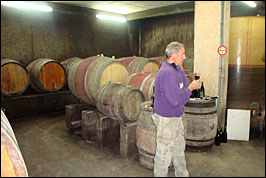
Joel Champet in his cellar.
|
Then it was off to Domaine Champet who own a fabulous single vineyard in La Viaillère. This strapping, thick, densely constructed wine was bottled 15 days ago and we were surprised to find that it is already for sale (so we ordered some....). There is no new oak at Champet - only old barrels, demi-muids and foudres. This is a wonderfully old-fashioned producer that reminded me a bit of the cellars at Rayas (although not quite as dirty). Joel Champet told us that "nature spoiled us in 2009". It is certainly the best wine that I have ever tasted from this producer.
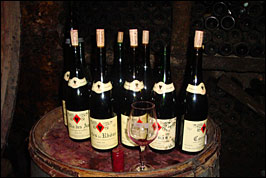
Samples on a barrel at Domaine Clape.
|
The afternoon visit was a real treat as we had a rendezvous at the legendary Domaine Clape. 3 generations of Clape were there to greet us. Auguste, (born 1925), Pierre, (born 1950), and Olivier, (born 1979). Great people and great wine. Clape is so clearly the best producer in Cornas that it's a long way back to second place - whoever that may be! The Clape tasting started with probably the best Vin de Table that I have ever tasted in my life. The "Vin des Amis" 2009 (the vintage is now permitted on the label of Vin de Tables for the first time) is made from flat vineyards near the river but still delivers a great mouthfull of sweet, licorice infused Syrah. 330 cases produced. Then it's on to the Côtes du Rhône which is made from a strip of land adjoining Cornas proper.
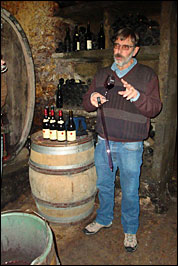
Pierre Clape, pipette at the ready.
|
This is more serious, focussed and classy. Apparently some of the vines that make this are 80 years old. Then we hit Cornas itself. The Cuvée Renaissance is made from vines that are between 12 and 16 years old. This has a perfumed nose and at first seemed quite forward but there were some firm tannins at the finish. This represents a third of the production of Clape Cornas. The grand vin itself was not yet assembled but is made from parcel of vines that are 30 to 60 years old. There is fabulous concentration here, licorice, truffles and black olives. Certainly a classic wine and one that will need a good 10 years of cellaring. The Clapes described 2009 as being like 2003 but with much better acidity and like 1999 but less classically structured.
The next day we kicked off at what is probably the greatest Domaine in the Rhône Valley - Jean-Louis Chave. Jean-Louis and his father Gerard showed us round the dark cellars where the wines from all the individual parcels are being matured, unblended. Jean-Louis is convinced that great Hermitage can only be produced by the blending of the different and differing lieu-dits and doesn't believe in the modern concept of single vineyard Hermitage. The wines here were, of course, brilliant. The white wine full of marzipan, honey and spice with a round, creamy texture. There is also some very good red St Joseph including a new vineyard recently purchased - Clos Florentin. Tasting through the various Hermitages - Peleat, Les Beaumes, L'Ermite, Méal, les Bessards etc was fascinating. Jean-Louis believes that 2009 is a rare vintage that achieved perfect ripeness but has good acidity and structure too. We did hear the word "perfect" used rather a lot in the Northern Rhône....
Then on to Alain Graillot. Alain's aimiable son Max looked after us and showed us his own Domaine des Lises as well as the Graillot wines. These are moderately priced wines that deliver great quality for the price. The white Crozes is made from 80% Marsanne, 20% Roussanne and the aromatic and peachy (he swore there was no Viognier in it) 2010 is 1/3 in tank, 1/3 in demi muids and 1/3 in barrel. The red is classic Northerm Rhône Syrah with pepper and spice.
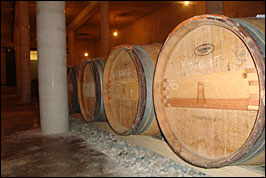
Latour barrels enjoying a second life in the Rhône.
|
The last visit of the day was to the remarkable and brand new Domaine Fontbonau which is situated in the very North of the Southern Rhône 8 kilometres from Valréas. This estate is co-owned by Frédéric Engerer who is the President of Chateau Latour. The brand spanking new winery seemed rather empty as the 11 hectares of vines had produced Syrah at just 10 hl/ha and Grenache at 22 hl/ha.
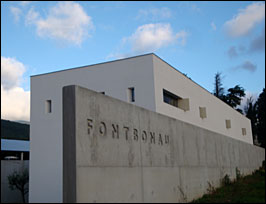
Domaine de Fontbonau.
|
The 2009 is still in barrels which spent one vintage at Chateau Latour before crossing France to spend another year here. The final blend (80% Grenache, 20% Syrah) will be blended and bottled in January. There will be a little over 1000 cases of Fontbonau's grand vin in 2009. There is a nice touch of vanilla and spice on the nose here as well as a creamy texture from the barrel ageing. Then the wine itself comes out of its comfy shell with hot, roasted meat and garrigue flavours. Fascinating stuff from a man who really knows what he is doing.
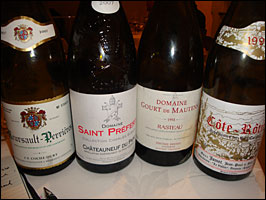
Four bottles less in the cellar at Beaugraviere.
|
The evening was spent at La Beaugraviere, which Rhône fans will know, is a truffle restaurant with quite simply the greatest Rhône wine list in the world. We were spoiled for choice and followed a Meursault Perrieres from Coche Dury with a 100 point Chateauneuf, a recommended off-piste 1998 Rasteau and then finished off with a 1999 Côte Rôtie from Jamet. There were four of us by the way....
Our final day saw three morning visits in Chateauneuf du Pape. First stop was at Vieux Donjon where the Lucien family make a classic Chateauneuf from 75% Grenache, 10% Mourvedre, 10% Syrah and 5% Cinsault and other varieties. About 3000 cases per annum are produced. This 2009 had a lovely rich, expressive, plump nose with garrigue flavours, chewy ripe Grenache fruit and a seductive, almost luscious mouthfeel. The yield here was 29 hl/ha in 2009 compared to 35 hl/ha in 2007. The 2007 vintage was then produced in a decanter. It was awesome and I honestly think that 2007 is the greatest vintage ever in Chateauneuf. 2009 is "merely" excellent and seems be on a level with the great wine produced here in 2001 and just above 2005.
The next visit was to Domaine des Senechaux which has recently been bought by "outsiders" - the Cazes family from Lynch Bages in Bordeaux. As we arrived at the winery, barrels from Lynch Bages (that a few days ago were maturing 2008 Lynch Bages) were being unloaded. The Syrah (18%) and Mourvedre (14%) here are aged in Lynch barrels whilst the Grenache (65%) is matured the traditional way in giant foudres. The 2009 here was also served alongside the 2007 and it was very similar in quality. This is not a blockbuster Chateauneuf. It has attractive red cherries on the nose with a sophisticated, creamy, smooth texture and fine tannins. Pure, focussed and not, fortunately, a head-banger. Impressive stuff, it seems like the Bordeaux influence here has tamed some of the wilder, more savage elements of the Southern Rhône.
Finally it was on to Beaucastel where we were met by Marc Perrin. Everything at Beaucastel is impeccable. The white wines are clearly the finest of the Southern Rhône (and by quite a long way). The Roussanne Vieilles Vignes is spectacular with a wonderful honeysuckle aroma but the "regular" Beaucastel Blanc, itself 80% Roussanne, is fabulous too.
We started our red tasting here with the Perrin family's Vinsobres les Cornuds. This wine differs from others here as it is grown at altidude (200-300 metres) and contains 50% Syrah. In a hot, dry year like 2009 the Grenache can be a bit too heady on its own and this wine offers sensational value for money. There is the elegance and pepper of the Syrah with the flesh and cherry flavours of the Grenache. The Perrins have fallen for Vinsobres in a big way and now own 60 hectares there. Their top cuvée "les Hauts de Julien" is a wine to look out for - but only 500 cases were produced.
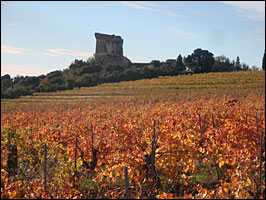
Autumn at Chateauneuf du Pape.
|
The Coudoulet de Beaucastel Rouge 2009 is, as usual, a Chateauneuf du Pape in all but name. The old vines here are just outside the appellation and this 2009 Coudoulet is very good indeed. Complex and earthy. Made from 30% Grenache, 30% Mourvedre, 20% Syrah and 20% Cinsault.
Then on to Beaucastel itself. Not surprisingly, the 2009 is superb and Marc was so confident in its quality that he followed it with the famous 2001. Make no mistake, this is a top Beaucastel that is certainly in the Premier League even if it can't quite match the sensational 2007 - which is the best wine ever made here, and already sold out at the Domaine.
Conclusions then. 2009 is a truly great vintage in the North combining rich fruit and structure. In the South it is a very good vintage indeed with fine balance. If you are visiting the Rhône then Beaugravière is a "must" and I would also recommend the friendly Le Chaudron in Tournon which has a great and modestly priced wine list. Vive Le Rhône!